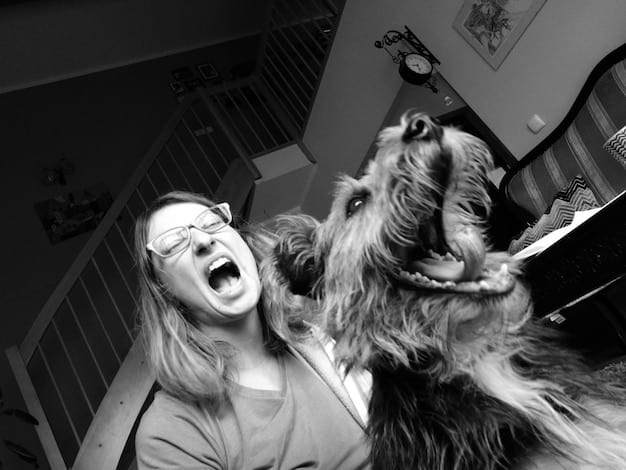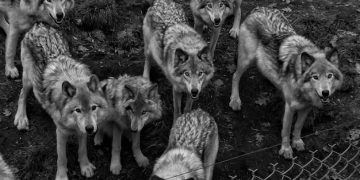Decoding Canine Body Language: 5 Signals for Training Success

Decoding canine body language is crucial for effective training; understanding signals of stress, fear, or discomfort enhances communication and strengthens the bond between you and your dog, leading to better learning outcomes.
Unlock the secrets to successful dog training by decoding canine body language. Many owners miss subtle cues that can significantly impact their dog’s ability to learn and their overall training success.
Understanding Canine Communication: More Than Just Barks
Dogs communicate primarily through body language. Paying attention to these signals can dramatically improve your training efforts and strengthen your relationship with your furry friend. It’s a language barrier we can bridge with careful observation.
Learning to interpret these subtle signs is essential for effective training rather than relying solely on traditional commands and treats.
The Importance of Attentive Observation
The key is to be observant. Notice how your dog holds their body, the position of their ears, and the expressions on their face. These cues can tell you a lot about their emotional state.
- Understand that context matters. One signal can mean different things depending on the situation.
- Observe your dog in various environments to better understand their baseline behavior.
- Record your observations to help you identify patterns and better anticipate your dog’s reactions.
Recognizing discomfort or stress signals allows you to adjust your approach and create a more positive training environment.

Signal 1: Whale Eye (Or Half-Moon Eye)
One of the most common signals owners miss is “whale eye,” or “half-moon eye.” This is when you can see the whites of your dog’s eyes, usually at the side, without them turning their head. It’s a clear sign of discomfort or anxiety.
A dog showing whale eye is telling you they are not comfortable with the situation.
What Does Whale Eye Signify?
Whale eye is a signal that your dog is feeling uneasy or threatened. It’s their way of saying, “I’m not sure about this.” This can be particularly relevant in training scenarios.
- Stop the training exercise immediately if you notice whale eye.
- Assess the situation and identify what might be causing the discomfort.
- Reassure your dog with a calm voice and gentle touch.
Avoid pushing your dog further when they exhibit whale eye. Instead, back off and reassess your training approach.
Signal 2: Lip Licking and Yawning
Lip licking and yawning are often misinterpreted as signs of hunger or tiredness, but they can also indicate stress or anxiety in dogs. These are displacement behaviors, meaning they are used to release tension.
Context is crucial when interpreting these signals.
Differentiating Stress from Normal Behavior
It’s important to distinguish between normal lip licking (after eating, for example) and stress-related lip licking. Similarly, a yawn in a relaxed setting is different from a yawn during a training session.
Pay attention to the frequency and context of these behaviors. If they occur repeatedly during training or in a specific environment, they are likely stress signals.

Signal 3: Tucked Tail and Hunched Posture
A tucked tail and hunched posture are classic signs of fear and anxiety in dogs. These signals are often easy to recognize, but sometimes owners underestimate their significance.
Understanding the intensity of these signals is critical for your dog’s well-being during training.
Addressing Fear and Anxiety
A dog with a tucked tail and hunched posture is feeling vulnerable and scared. Pushing them in this state can lead to negative associations with training, making it harder for them to learn in the future.
- Create a safe and positive training environment.
- Use positive reinforcement techniques to build confidence.
- Avoid punishment-based methods, which can exacerbate fear and anxiety.
Allow your dog to approach new situations or people at their own pace. Never force them into uncomfortable interactions.
Signal 4: Avoidance Behavior
Avoidance behavior can manifest in various ways, such as turning their head away, walking away, or even hiding. These actions indicate that your dog is trying to escape something they find unpleasant or threatening.
Recognizing and respecting these signals can help you build trust and avoid unnecessary stress.
Recognizing Subtle Signs of Avoidance
Avoidance can be subtle, like a slight head turn, or more obvious, like walking away. The key is to be attentive to your dog’s body language and respect their boundaries.
Forcing a dog to engage when they are clearly trying to avoid something can damage your relationship and hinder training progress.
Signal 5: Stiff Body and Freezing
A stiff body and freezing are signals that a dog is feeling tense or uncertain. This behavior often precedes more overt signs of aggression, so it’s crucial to recognize it early. “Freezing” refers to when a dog momentarily halts all movement.
These signs can be early indicators of potential escalation, so paying attention can prevent unnecessary conflict.
Preventing Escalation
A dog that is stiff and freezing is often trying to assess the situation before deciding on their next move. This can be a sign that they are feeling threatened and may resort to aggression if pushed.
- Give them space and time to decompress.
- Avoid direct eye contact, which can be perceived as a threat.
- Speak in a calm and reassuring voice.
Understanding these signals can help you prevent potentially dangerous situations and create a safer environment for both you and your dog.
| Key Signal | Brief Description |
|---|---|
| 👀 Whale Eye | Shows whites of eyes; indicates discomfort. |
| 👅 Lip Licking | Stress/anxiety signal, not always hunger. |
| 😥 Tucked Tail | Fear and anxiety; feeling vulnerable. |
| 🚶 Avoidance | Escaping; respect their boundaries. |
Frequently Asked Questions
▼
Understanding dog body language allows you to communicate effectively, avoid stress, and build a stronger relationship with your dog, leading to more successful training.
▼
By recognizing stress signals during training, you can adjust your approach, creating a more positive learning environment and encouraging willingness to cooperate.
▼
If your dog exhibits stress signals, stop the training session immediately, reassess the situation, and reassure your dog. Avoid pushing them further to prevent negative associations.
▼
Yes, ignoring these signals can cause increased stress, anxiety, and fear in your dog. It can also damage your relationship and make future training sessions more difficult.
▼
Create a positive and safe environment by using positive reinforcement, avoiding punishment, and respecting your dog’s boundaries. Allow them to approach new things at their own pace.
Conclusion
By learning to decode these five key signals, you can improve your communication with your canine companion, create a more positive training environment, and strengthen the bond you share. Paying attention to your dog’s body language is an investment that pays dividends in a happier, healthier relationship.





